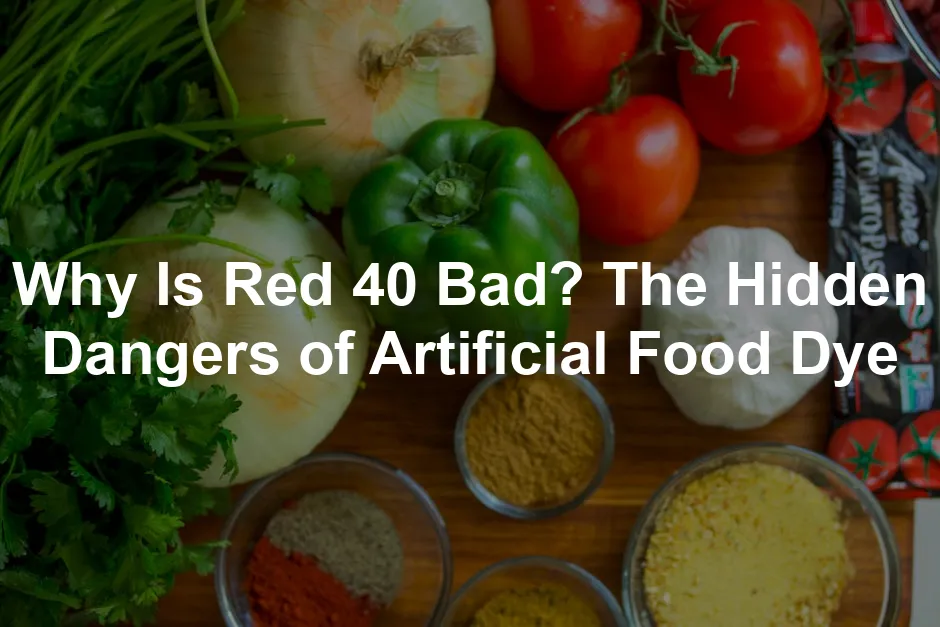
Why Is Red 40 Bad? The Hidden Dangers of Artificial Food Dye
Introduction
Have you ever wondered what makes those bright red candies so eye-catching? That vibrant hue often comes from Red 40, a common synthetic food dye. You’ll find it in countless processed foods, from snacks to beverages. However, many people are questioning its safety. This article will discuss the potential negative effects of Red 40 and why it could be a concern for you and your family.
If you’re looking for a natural way to add color to your meals without the artificial nonsense, consider switching to Beet Juice Powder. It offers that same pop of color without the synthetic baggage. Plus, it comes with a nutritional boost—what’s not to love?
Summary and Overview
Red 40, also known as Allura Red AC, is a petroleum-based dye that enhances the color of many food products. It’s widely used due to its appealing appearance and low production cost. Despite its approval by the FDA and other regulatory bodies, public debates about its safety continue. Critics link Red 40 to various health issues, especially in children. This article will cover key concerns, including behavioral impacts, potential allergies, and regulations surrounding this artificial dye.
For those who enjoy a little crunch with their color, how about some Skittles Candy? Just remember, while they’re a rainbow of flavor, they also come with a side of Red 40. Why not balance it out with a healthy option later?
What Is Red Dye 40?
Overview of Red Dye 40
Red Dye 40 is a synthetic color additive derived from petroleum. It’s one of the most commonly used food colorings in the United States. The FDA has approved it for use in various food and beverage products, ensuring it meets safety standards. You might see it on labels as Red 40, Allura Red AC, or FD&C Red No. 40. While many enjoy the vibrant color it brings to their favorite foods, it’s essential to understand the potential risks associated with its consumption.
Prevalence of Red Dye 40 in Foods
Common Products Containing Red Dye 40
Red Dye 40 is everywhere in processed foods. You might find it in:
- Candies like Skittles and M&Ms
- Breakfast cereals such as Fruity Pebbles and Lucky Charms
- Ice creams and frozen desserts
- Snack foods like Doritos and Cheetos
- Baked goods, including cakes and cupcakes
Food manufacturers often use Red Dye 40 to make products visually appealing. This dye enhances the color of items, making them more attractive to consumers, especially kids. In fact, Red 40 is one of the most popular food colorings in the United States. It is estimated that around 15 million pounds of this dye are consumed annually, with over 40% of that being Red 40 alone.
If you’re planning to whip up some delicious treats at home, don’t forget to grab a Baking Supplies Set. Because let’s face it, trying to bake without the right tools is like trying to paint a masterpiece with a crayon!

Health Concerns Associated with Red Dye 40
Behavioral Issues in Children
Research has raised concerns about Red Dye 40‘s potential effects on children’s behavior. Some studies suggest a link between this dye and increased hyperactivity, particularly in children with ADHD. For instance, children consuming diets high in artificial colors showed more significant behavioral issues than those avoiding these dyes. In a notable study, about 10 out of 16 trials indicated a rise in hyperactivity among children exposed to artificial food dyes.
The prevalence of ADHD among children consuming processed foods with artificial dyes is alarming. It is estimated that around 9.4% of children in the United States have been diagnosed with ADHD, and many of these children are regular consumers of products containing Red Dye 40.
If you want to dive deeper into ADHD awareness, consider checking out the ADHD Awareness Book. Knowledge is power, and understanding these issues can make a world of difference.
Allergic Reactions and Sensitivities
While allergic reactions to Red Dye 40 are not widespread, they can be serious for sensitive individuals. Symptoms may include hives, asthma attacks, and skin irritations. Although such reactions are relatively rare, they highlight the potential risks for those with sensitivities. It’s essential for consumers to recognize these symptoms, especially when introducing new foods into their diets.
For some, even a small amount of Red Dye 40 can trigger these reactions, emphasizing the importance of reading labels carefully.

Potential Links to Cancer
Concerns about Red 40 often stem from its potential to contain benzidine. Benzidine is a compound that has been classified as a carcinogen. This raises alarms about the long-term safety of consuming products with Red 40. Although the FDA has deemed Red 40 safe, the presence of benzidine in its production process has made consumers wary.
Studies have shown that synthetic dyes, including Red 40, may be linked to cancer risks. Research indicates that high doses of certain artificial dyes can promote tumor growth in animals. While these findings are not conclusive for humans, they highlight the need for caution. Awareness about these potential risks is critical as consumers navigate their dietary choices.

Comparing Red Dye 40 to Other Food Dyes
Differences Between Red Dye 40 and Natural Alternatives
Red Dye 40 is a synthetic dye, unlike natural alternatives like beet juice and turmeric. Natural dyes come from plants and offer vibrant colors without synthetic chemicals. These alternatives are often seen as healthier options for coloring foods.
Using natural dyes has several benefits. They pose fewer health risks and are less likely to cause allergic reactions. Moreover, natural colorings have nutritional benefits. For example, beet juice is high in antioxidants, which contribute to overall health. You can easily find Turmeric Powder to brighten up your dishes with a sunny hue!
Many products have successfully switched to natural colorings. For instance, some companies now use beet juice instead of Red 40 in their candies. This shift appeals to consumers looking for cleaner, safer food options. As awareness grows, more brands are reformulating their products to eliminate synthetic dyes altogether.

Regulatory Perspectives on Red Dye 40
FDA and Global Regulations
The FDA has approved Red 40 as a safe food dye for consumption, but opinions about its safety vary. The agency asserts that it meets established safety standards. However, the European Union has stricter regulations. In Europe, artificial dyes are often required to carry warnings about potential effects on children’s behavior. Countries like Canada and Australia have taken even more stringent measures, banning certain artificial colors altogether.
Recently, California passed legislation aimed at banning specific artificial dyes, including Red 40, in school food. This move reflects growing public concern over the potential impact of synthetic dyes on children’s health and behavior. As awareness increases, more consumers are seeking clearer labeling and safer alternatives.

How to Read Labels
Identifying products with Red 40 can be tricky. To avoid it, check the ingredient list carefully. Red 40 can appear under several names, including:
- Allura Red
- FD&C Red No. 40
- Red 40 Lake
Always look for these names when shopping. Many processed foods, including candies, cereals, and beverages, contain this dye. By staying vigilant and reading labels, you can make informed choices about what you and your family consume.

Alternatives to Red Dye 40
Natural Coloring Options
If you want to avoid Red 40, there are plenty of natural alternatives. Many consumers are seeking healthier options for food coloring. Natural ingredients can replace synthetic dyes effectively. Here are some popular natural coloring agents:
- Beet Juice: Provides a vibrant red hue.
- Turmeric: Offers a bright yellow shade.
- Blueberry Juice: Adds a lovely blue color.
- Spirulina: A blue-green algae that adds color.
- Carrot Juice: Great for orange coloring.
More companies are reformulating their products to eliminate synthetic dyes. This trend reflects growing consumer demand for cleaner, safer food options. Brands are increasingly using natural colorings, contributing to a healthier food landscape. Looking for a great way to blend those natural colors? A Smoothie Blender can help you whip up colorful and nutritious drinks in no time!

Recommendations for Consumers
Practical Tips for Reducing Red Dye 40 Intake
Want to cut back on Red 40? Here are some simple tips to help you out:
- Choose Whole Foods: Focus on unprocessed items like fruits and vegetables. These typically don’t contain artificial dyes.
- Read Labels Carefully: Always check ingredient lists. Look for names like Allura Red or FD&C Red No. 40.
- Educate Your Kids: Talk to your children about food dyes. Help them understand the importance of making healthier choices.
By following these steps, you can significantly reduce your intake of Red 40 and other artificial dyes. Making informed dietary choices is key to maintaining health. Speaking of choices, don’t forget to stock up on some Organic Fruit Snacks for a tasty treat that’s guilt-free!

Conclusion
In summary, Red Dye 40 poses potential risks, especially for children. Concerns include hyperactivity and allergic reactions. Opting for natural alternatives can create safer food experiences. As consumers, it’s vital to stay informed and make better choices. Consider the impacts of artificial dyes on your health. Together, we can foster a healthier food environment for everyone. Plus, if you’re feeling adventurous in the kitchen, check out some Cookbooks for Healthy Eating to spark your culinary creativity!

FAQs
What is Red Dye 40 and where is it found?
Red Dye 40, also known as Allura Red AC, is a synthetic food coloring. It’s commonly found in candies, cereals, and beverages.
Is Red Dye 40 safe for children?
Some studies suggest it may affect behavior in children, especially those with ADHD. Moderation is key.
What are the symptoms of Red Dye 40 allergy?
Symptoms can include hives, skin irritations, and breathing difficulties. Consult a healthcare provider if you suspect an allergy.
How does Red Dye 40 compare to natural dyes?
Natural dyes, derived from plants, are generally safer and offer health benefits. They lack the synthetic chemicals found in Red 40.
What regulations exist regarding Red Dye 40?
The FDA has approved Red 40, but some countries have stricter regulations, including warning labels.
How can I avoid Red Dye 40 in my diet?
Read labels carefully and choose whole, unprocessed foods to avoid artificial dyes.
Are there any health risks associated with consuming Red Dye 40?
Ongoing research discusses links to hyperactivity and allergic reactions, making caution advisable.
Please let us know what you think about our content by leaving a comment down below!
Thank you for reading till here 🙂
All images from Pexels




